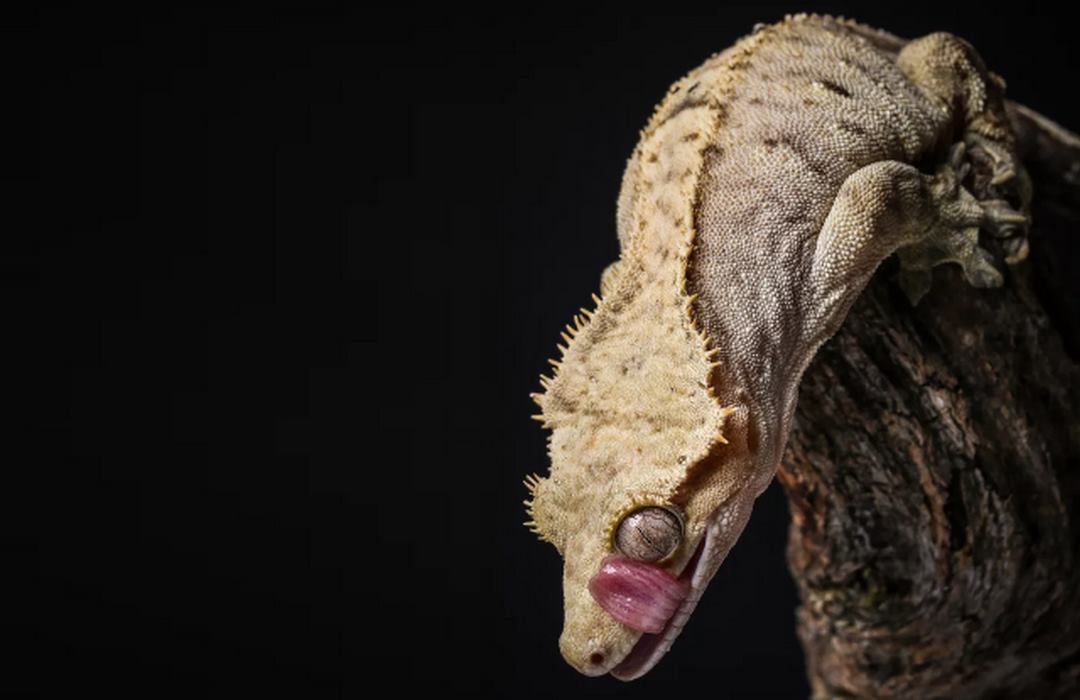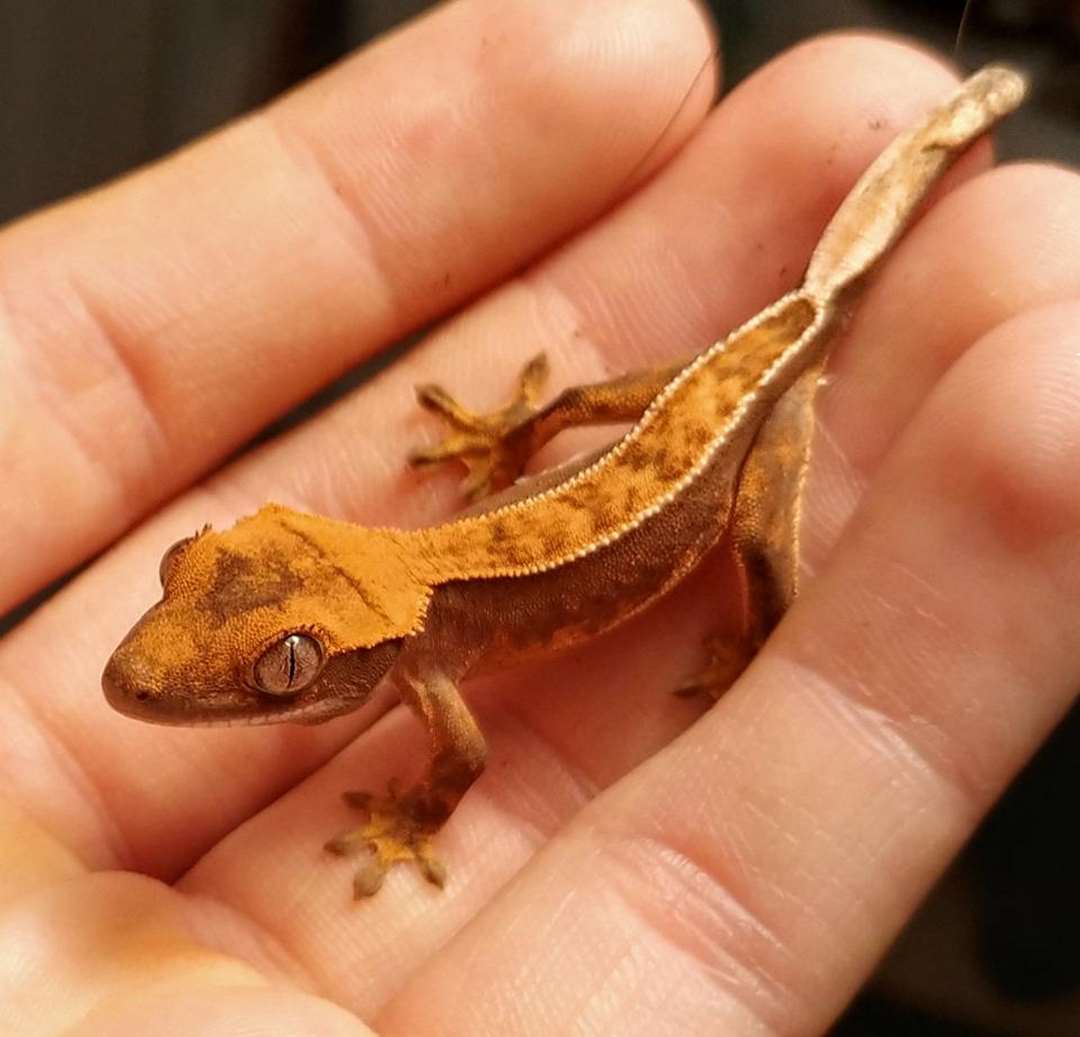The Crested Gecko was once thought to be extinct, but it was “rediscovered” around 1994. Since then, their popularity as pets has skyrocketed. They are low-maintenance animals, making them a great choice for children or beginner reptile owners who may not have a lot of time for daily care.
One of their most notable features is their eyelashes, which is why they are sometimes called “eyelash geckos.” These lizards come from New Caledonia, an island nation off the coast of Australia.
1. Overview of the Crested Gecko
- Other names: Crested Gecko, Crestie, Caledonian Gecko, Eyelash Gecko
- Scientific name: Rhacodactylus ciliatus
- Size: 7-9 inches, including their prehensile tail
- Lifespan: 10-20 years
2. Behavior and Temperament
Crested Geckos come in a wide range of colors and patterns (morphs). They are named after the crested fringe that runs from their eyes down their necks and along their backs, though the size of this crest can vary.
These geckos have specialized toe pads that allow them to easily climb vertical surfaces, and their prehensile tails add to their agility. They are also excellent jumpers.
Crested Geckos are generally docile, although they can be a bit jumpy and need to be handled carefully. They usually don’t like being handled too much, so it’s best to avoid it when possible. If handled improperly, they may jump, which could lead to injury. They can also drop their tails if frightened or handled roughly, and unlike other gecko species, they won’t regrow their tails.
They will only bite if they feel threatened. While the bite might be startling, it’s not painful and won’t break the skin.
3. Housing Your Crested Gecko
A minimum 10-gallon vertical tank is sufficient for one adult gecko, but bigger is always better. Cresties are active, arboreal creatures, so they need plenty of vertical space for climbing. A 15-gallon tank can house two or three geckos, but males are territorial, so keep only one male per tank. You can use a glass terrarium with a mesh side for ventilation, though some prefer using mesh tanks.
Crested Geckos need plenty of climbing opportunities, so provide a mix of branches, driftwood, bamboo, cork bark, and vines at varying heights and angles. Add a variety of silk or sturdy live plants (such as pothos, philodendron, dracaena, or ficus) for them to hide among.
Daily, you should remove uneaten food and spot-clean the habitat to remove waste. Thoroughly clean the terrarium and its decorations at least once a month using reptile-safe disinfectants. Depending on the substrate, you may need to replace it weekly or monthly to prevent bacteria buildup.
3.1 Temperature
As cold-blooded animals, reptiles need to regulate their body temperature. Aim for a daytime temperature gradient between 72°F and 80°F (22°C – 26.5°C) for your Crested Gecko, with a nighttime drop to 65°F – 75°F (18°C – 24°C). Use a thermometer to ensure the tank doesn’t overheat.
Crested Geckos can become stressed at higher temperatures. A low-wattage red night bulb can provide a good heat source and allow you to observe your gecko at night when they are most active. Avoid placing the heat source on the tank’s lid as they may climb too close and get burned.
3.2 Lighting
Crested Geckos are nocturnal, so technically they don’t need special UVB lighting. However, some experts believe that low levels of UVB (around 5%) can benefit their overall health. Be aware that any additional lighting will raise the temperature, so monitor it closely. Also, provide hiding spots where your gecko can escape the light if they want.
3.3 Humidity
Crested Geckos require moderate to high humidity levels. Aim for 60% during the day and 80% at night. Use a hygrometer (humidity gauge) to monitor this. Maintain the humidity by misting the enclosure regularly with warm, filtered water. Depending on your setup, you may need to mist the tank multiple times a day to keep the humidity up.
Ensure the enclosure is well misted at night when the gecko is most active. If you’re away during the day or can’t mist the tank yourself, consider using a fogger or automatic mister to maintain humidity on a schedule.
3.4 Substrate
Most pet owners use substrate to line the bottom of the tank. When choosing one for your gecko, consider its safety, ease of cleaning, and whether it helps maintain humidity. Ideal substrates include coconut fiber bedding, moss, or peat. You can also use newspaper or paper towels, although they’re less visually appealing.
Crested Geckos tend to ingest substrate while hunting; if this happens frequently, use sphagnum moss (alone or layered over another substrate like coconut fiber) or paper towels. Paper towels are recommended for juveniles since they’re more likely to accidentally swallow other types of substrate.
Although visually attractive, gravel or pebbles are not suitable substrates because they’re difficult to clean thoroughly. Avoid sand and non-organic reptile soil, as these pose ingestion hazards.
3.5 Food and Water
Since they are nocturnal, feed your gecko in the evening. Baby geckos should be fed daily, and adults three times a week.
Commercial gecko diets are widely accepted and the easiest way to ensure a balanced, nutrient-rich diet. Supplement their diet with crickets and other live prey (such as roaches, waxworms, or silkworms). Avoid mealworms as they have tough exoskeletons and are difficult to digest. For variety and to let your gecko practice its hunting instincts, offer multiple live insects at once when your gecko is most active.
Insects should be slightly smaller than the space between the gecko’s eyes and should be gut-loaded (fed nutritious food) before being offered. To boost your reptile’s vitamin and mineral intake, dust insects with a calcium/vitamin D3 powder three times a week, and dust with a multivitamin once a week.
Offer fruit a few times a week. Try mashed fruits or canned baby food. Favorites include bananas, peaches, nectarines, apricots, papaya, mango, pears, and passion fruit.
If you can’t find commercial gecko diets, a combination of live prey and fruits will suffice in the short term. Crickets should be the primary insect, with other bugs added occasionally for variety.
Provide a small dish of fresh water, changed daily, though they may prefer drinking water droplets off leaves in their moist habitat.
4. Common Health Issues
Crested Geckos are susceptible to some health issues that can be treated by a qualified exotic vet.
- Mouth rot or stomatitis: Signs include excessive mucus and redness around the mouth.
- Respiratory infections: Symptoms include wheezing or excess mucus.
- Skin problems: Rashes, symptoms of parasitic infections, or difficulty shedding, which may result from inadequate humidity.
5. Choosing a Crested Gecko
Crested Geckos are readily available, mainly because they’re easy to care for and more sun-tolerant than other lizards. Although they’re widely available at pet stores, try to purchase your gecko from a reputable breeder. Prices range from $40 to $600, with rare colors or morphs commanding higher prices.
When choosing a gecko, ensure it climbs well, has a straight spine, and that ribs or pelvic bones aren’t visible.
It should appear lively and alert, with bright eyes and a clean nose and vent (anus)






